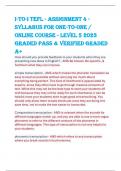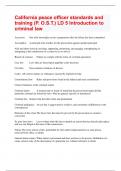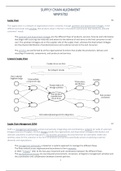i-to-i TEFL - Assignment 4 -
Syllabus for one-to-one /
online course - Level 5 2023
GRADED PASS & VERIFIED GRADED
A+
How should you provide feedback to your students when they are
presenting new ideas in English? - ANS-Be honest, Be specific, &
Tell them what they can improve
simple transcription - ANS-which makes the phonetic translation as
easy to read as possible without worrying too much about
everything being perfect. This kind of shorthand is appreciated by
experts, since they often have to go through massive amounts of
text. While this may not be the best type to start your students off
with because they may not be ready for such shorthand, it can be
helpful once your students start to get good at transcribing. You
should only allow them to take shortcuts once they are doing it to
save time, not to make the text easier to transcribe.
Comparative transcription - ANS-is relevant when the sounds for
different languages match up, and you are able to use a more vague
phoneme to refer to the different versions of the phoneme in
different languages. This type of transcription is not very helpful to
your students.
phonemic transcription - ANS-which refers to any transcription
where you break sounds into phonemes.
,allophonic transcription - ANS-which means breaking the speech
down into allophones. If you remember from previous modules,
allophones are a phonic, rather than phonemic way of breaking
down words.
Word-for-Word Transcription 1 - ANS-Select or provide a text that
already has a transcription. There is no way to assess your students
unless you have an answer key. You can either hold onto the correct
transcription yourself to assess your students, or give it to them so
they can check their work and self-correct. When they are working
toward mastery, it is probably better to give them the transcription,
and when you are ready to assess their mastery, it is better to
assess them yourself.
Word-for-Word Transcription 2 - ANS-Have the students listen to
the speech once. If you are delivering the speech, read it through
once, instructing the students not to write anything yet, but only to
listen. If the students have a recording, instruct them to listen to it
on their own once through before they do anything.
Word-for Word Transcription 3 - ANS-Have your students transcribe
the speech line-by-line. It would be helpful if they have a recording
of the speech so they are able to go back and re-listen when they
need to. However, you may want to simply speak the text when your
students have progressed to the point where they are strong enough
to handle it.
Word-for-Word Transcription Tips - ANS-If you have the opportunity,
use a digital recording so it is easier for students to go back and
forth and keep track of their progress.
Have the students write their transcriptions by hand to have a closer
connection to the words they are writing. Also, handwriting the
,transcriptions means they will not have access to grammar and
spelling software that will help them along the way, but will
ultimately hurt their learning.
Allow the students to use a dictionary whenever they need. Not only
will this give the students a reference piece to help, but it will also
give the students practice looking up words.
Do not limit the amount of times your students can rewind or listen
to parts of the recording. Even native English speakers would have
trouble transcribing a piece word-for-word without listening more
than once.
Encourage your students to transcribe the piece word-for-word,
then look through their transcription to fix errors in grammar and
usage, even when those errors were made by the original speaker.
This will give the students practice transcribing the piece, but will
also give them the opportunity to practice their revision skills and
access their knowledge of grammar.
Paraphrasing 1 - ANS-Start out slow and informally. Have your
students pair up (or get into small groups), and have them practice
paraphrasing. You can even have them start in their native language.
Give the students a simple question, like, "what did you do this
weekend?" Have the students interview each other, and then
paraphrase what their partner tells them. This helps them work on
both speaking and listening skills.
Paraphrase 2 - ANS-Do it with them. When you are starting to teach
the skill of paraphrasing, model the activity by participating in it with
them. Start by asking a student a question, then paraphrasing his or
her answer for the class. Then, do the same thing, but ask the class
to help you paraphrase. By initiating the process together, you will
make your students feel more comfortable, and you will show them
how it should be done.
, Paraphrase 3 - ANS-As you are modeling the process with the
students, help them understand how to paraphrase better by
introducing four strategies they can use:
Reword: The student replaces words with synonyms whenever he or
she can.
Rearrange: The student rearranges a sentence so that it sounds
different but conveys the same message. You will have to model
this for the students directly.
Accept: Let the students know they will not be able to change every
word (nor should they), so they need to learn to make decisions on
what needs to be changed and what should stay the same.
Recheck: Have the students read over the paraphrased version they
have written and evaluate it based on how accurate it is to the
original message. If you have the students working together, have
the student who delivered the speech check the student who
paraphrased for accuracy. You can also use this as an assessment
tool and evaluate it yourself.
Understanding Conversational English Tip 1 - ANS-Verb
conjugation: In order to effectively communicate during a
conversation, your students need to know the basics of verb
conjugation, especially when it refers to tense. The difference
between, "I ran to the store" and "I run to the store" is only a
difference of one letter, but it significantly changes the sentence.
Students do not have to be experts at this yet, but they should
understand the basics so they can participate in a conversation
without confusion
Understanding Conversational English Tip 2 - ANS-Using pronouns
properly: Pronoun use is important in conversational usage, as it is
a typical (and grammatically correct) way to take shortcuts to
meaning. It is important that you help your students by stressing the
importance of clear antecedents, as well as proper pronoun usage






